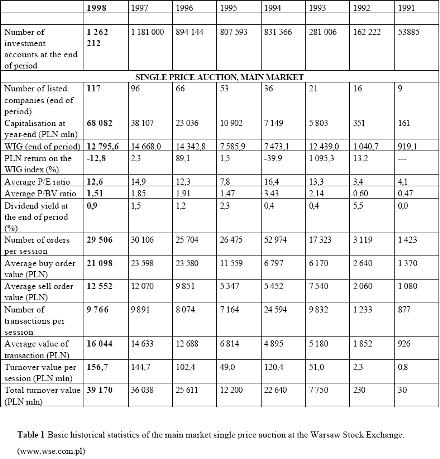The paper describes how 40 Polish financial analysts associate various kinds of economic, political news and technical analysis signals with the future stock prices. The financial analysts and dealers employed by various Polish capital market institutions were asked to mark a score to each item of the questionnaire, depending on how they estimated the impact of the item for the future behavior of stock prices. The principal axis method of factor analysis yielded 4 factors (including economic, political and “technical” measures) on which stock prices would depend explaining as much as 45% of total variance:
- The growth of foreign and domestic investments in stock market;
- The withdrawal of foreign and domestic investments from stock market;
- Unfavorable macroeconomic and political signals;
- Positive financial and macroeconomic signals.
The cluster analysis revealed that the participants marked most of items as strongly affecting future stock prices regardless if their nature was economic, political or “technical”. Considering many esoteric signals, indicated by respondents as responsible for stock market movements, the financial analysts seem to be subject to some psychological biases, which have big impact on their judgements.
INTRODUCTION
There is an evidence that stock prices are meaningful in the sense of reflecting some real economic variables. (Lorie, 1985) For the accurate prophecy of future stock prices, an identification of the factors leading stock market is needed. However, research shows that only a fraction of return variation can be explained by publicly known news. (Cutler, 1989), (Fama, 1981) The level of real dividends payments, industrial production, real money supply, interest rates, CPI inflation rate and market volatility can explain some fraction of share price movements.
The most of variation in returns cannot be explained using readily available measures of new information. In spite of a long list of publications proving that market movement is random (Cootner, 1964) or at least very difficult to predict (Lo, 1999), a lot of effort is made in order to foresee future prices (Bernstein, 1992). Stock movements might be random but correlated with some (also randomly occurring) economic or political news.
What more, the precise market prediction based on public news is much more difficult than the post hoc linking of major market movements to the release of economic or other information. Research carried out by De Bondt and Thaler (1990) shows that stock prices changes forecasted by students were too extreme to be considered rational. Similar pattern of overreaction found in the predictions of naive undergraduates was replicated in the predictions of stock market professionals. The authors’ inference from the research is to take seriously behavioral explanations of anomalous financial market outcomes.
As Cray and Haines (1992) noticed that the portfolio management, in spite of several normative models existence, was not well understood in a purely descriptive sense. Cray and Haines’s work concentrated on verbal descriptions about how financial managers really make investment decisions. The present research shows how financial analysts associate various kinds of news and technical analysis signals with the future stock prices. 60-item questionnaires were presented to 40 Polish financial analysts. All questionnaire participants managed funds at Warsaw Stock Exchange (WSE) in 1990’s.
The Warsaw Stock Exchange is the principal institution of Poland’s capital market. The first stock exchange in Warsaw opened in 1817. The World War II and the subsequent decades of communism interrupted exchange operations. The Warsaw Stock Exchange commenced the activity in its present form in 1991, with electronic paperless trading and regulations based on the modern international standards. Following a review of several contemporary markets, a system based on French experience was adopted and implemented. In October 1994, the Warsaw Stock Exchange was admitted as a full member to the International Federation of Stock Exchanges.
Transactions are concluded in two systems: single-price auction and the continuous trading. All companies are traded in the single-price auction system. Shares of the most liquid companies of the main market are also traded in the continuous quotation system. Company shares may be listed on the Exchange in three different markets: the main, parallel and free market. Disclosure requirements are the same for all companies, regardless of their quotation market. The quotation market is indicative of the liquidity and risk level resulting from a company size as well as its history and the financial results achieved in the past. Table 1 shows some basic statistics of the Warsaw Stock Exchange for the last few years.

Prof. Piotr Zielonka
Next: Method
Summary: Index